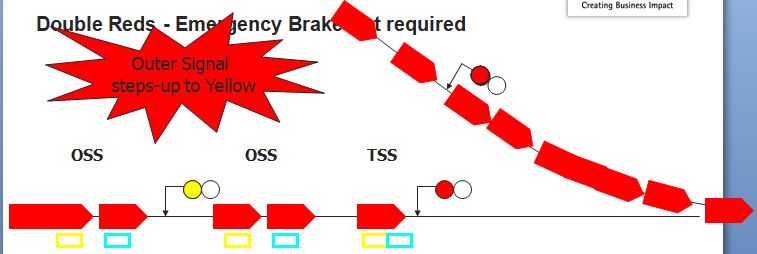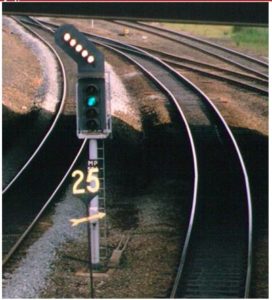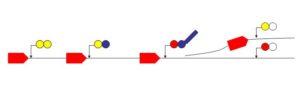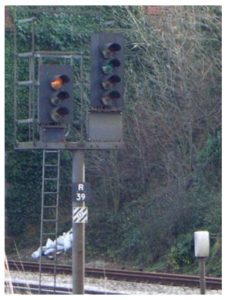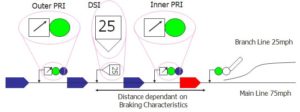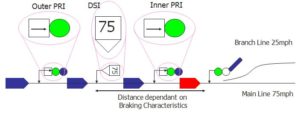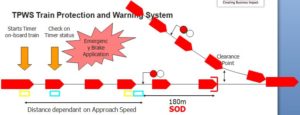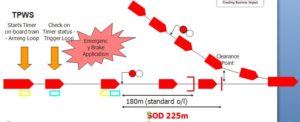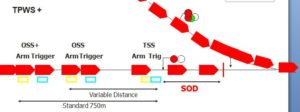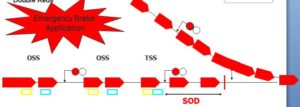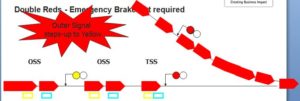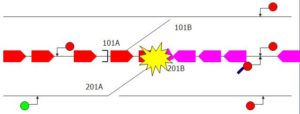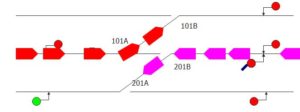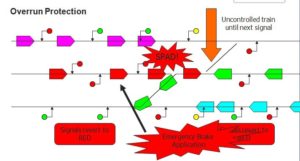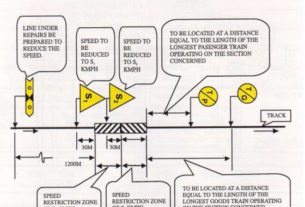Railway Junction Signalling and Robust Train Protection
Signalling Principles
- Network to deliver High Quality Train Performance
- Previous Signalling:
Based on a narrow set of Rolling Stock characteristics AND
Assumed exemplary Driver performance AT ALL TIMES
- Realistic future expectations
Drivers NOT perfect so need more useful information
Provide ‘back-up’ plan for inevitable overrun
‘Back-up’ plan should NOT impact heavily on performance
- Two techniques focussed on performance on the prevention of, and reaction to, overruns:
IMPROVED JUNCTION SIGNALLING
ROBUST TRAIN PROTECTION
Junction Signalling
- Junction Signalling is the process of providing information to the driver of his forward route on the approach to a junction.
- Two possible areas of danger at diverging junctions are:
The train has been signalled correctly, but the driver has failed to adjust his speed accordingly
The train has been signalled incorrectly and the driver has failed to stop on the approach to the junction.
- These hazards can be mitigated against by providing the driver with more useful information on his approach to the junction, to give him more time to analyse and react to the information given, and if in doubt, stop in time.
- RSSB recently completed a review of junction signalling to investigate improved methods of giving the driver more effective information. Previous junction signalling focussed on the signalling systems capabilities, whereas, the new study, takes a human factors approach, worked WITH the driver to achieve the optimal procedure.
- There are currently 5 methods of junction signalling in the UK.
Main Aspect Free: (MAF)
- Aspect Sequence as if plain line.
Approach Release from Yellow: (MAY-YY)
- Junction signal steps-up when the aspect AND Junction Indicator are both readable
- The signal in advance of the junction signal can only show a proceed aspect IF the driver cannot see the signal on the approach to the junction signal. There must be no ‘read-through’.
- If the signal can be seen, then it must be held at red until the junction signal steps up.
Splitting Distants: (MAF-SD)
- Standard Aspect Sequence shown to driver
- Driver is responsible fully for controlling speed over junction.
Splitting Distants
- The diverging route head cannot show a Red Aspect
Approach Release from Yellow with Flashing Aspects: (MAY-FA)
- Junction signal steps-up when the aspect AND Junction Indicator are both readable
- Signal in advance of junction signal can only show proceed aspect if no ‘read-through’ possible
Approach Release from Red: (MAR)
- Junction signal steps-up when the aspect AND Junction Indicator are both readable
- Most restrictive method as the signalling controls the drivers speed
Future of Junction Signalling
- Recent findings from a study commissioned by RSSB recommended two options to be considered together to help to provide the driver with more information regarding his forward route, so he can make an informed decision about the junction.
Preliminary Route Indicators. These provide the driver with extra information of the direction he is signalled to travel across the junction. They use illuminated arrows, similar to a Position Light Junction Indicator, but include the straight-through route.
Dynamic Speed Boards. These are situated on the approach to the junction signal, and illuminate the appropriate speed for the junction as the train approaches it. Different values will be shown for the various routes set. This will act as a reminder to the driver to control his speed.
Preliminary Route Indicators and Dynamic Speed Indicators
- Train Signalled onto the Branch Line.
- Speed must be reduced from 75mph to 25mph.
- Position of Dynamic Speed Indicator is dependant upon the speed reduction required.
Preliminary Route Indicators and Dynamic Speed Indicators 1
- Train Signalled onto the Main Line
- Speed does not have to be reduced
- Position of Dynamic Speed Indicator shows the default speed of 75mph
Robust Train Protection = RTP
- Invokes train protection by ‘measuring’ train speed on the approach to a signal at red, trying to prevent a SPAD
- Manages the overrun to the safest possible destination
- Ensure authority is removed from infringed routes, that is, placing other signals to danger
- Practical principles of RTP
Apply TPWS for speeds up to 65mph
Apply TPWS+ for speeds up to 95mph
Apply TPWS OSS at outer signal to provide ‘Double Red’ protection
Align Overlaps towards the safest destination
Provide Flank Point Protection
Provide Overrun Train Detection
TPWS Train Protection and Warning System
- Safe Overrun Distance 180m
- Maximum Speed 65mph
- Fully Effective TPWS at the OSS will stop train by the Safe Overrun Distance
TPWS
- Safe Overrun Distance 225m
- Maximum Speed 75mph
- Fully Effective TPWS at the OSS will stop train by the Safe Overrun Distance of 225m.
TPWS +
- Insufficient Safe Overrun Distance for Speed for TPWS alone
- Maximum Speed 95mph
- Full intervention from TPWS at the OSS+ will stop train by the Safe Overrun Distance of 225m
- If train passes under the OSS+ speed, but is travelling at a higher speed at the OSS then the emergency brake will activate at that point. The same for the Train Stop
Double Reds
- Insufficient Safe Overrun Distance for Speed for TPWS
- For Speeds over 95mph,
- Or where Head-On collision speeds > 100mph
- Full intervention of TPWS at the outer signal OSS will stop train in the Safe Overrun Distance of 225m.
Double Reds – Emergency Brake not required
- If, when passing the Outer Signal OSS, the train is travelling at a slow enough speed not to require application of the emergency brake, the the outer signal will step-up to a Yellow aspect, to allow the train to approach the junction signal at Red.
Flank Protection and Point Locking
- No Locking required between the authorised route and 101 Points
- Calling Flank Points diverts the potential collision
- Points 101 MAY NOT always be available.
- May be advantageous to number point ends separately
- Always consider type of collision – would rather have side swipe than head-on collision.
Overrun Protection
- Automatic Emergency Brake Applications will ensure that trains are brought to a stand to minimise impact of a collision of an overrunning train.
Conclusion
Serious accidents have highlighted the need for increased restrictions on the railway.
Providing the driver with more information, and well in advance of the junction signal, will give him more time to react accordingly. This is in line with new higher speed turnouts required on the network to improved performance.
Robust Train Protection using full TPWS protection has already provided safety benefits. Increased application of TPWS and better signalling design ‘past the overlap’ will increase safety, whilst avoiding impacts on the network performance.
Accidents following human error cannot completely be avoided, however robust mitigation methods must be applied consistently.
RTP and aligned overlaps are techniques borrowed from the era of lever frames – updated for modern traffic volumes and train speeds.
Signalling Principles, Railway Junction Signalling and Robust Train Protection, IMPROVED JUNCTION SIGNALLING, ROBUST TRAIN PROTECTION,Junction Signalling,Main Aspect Free: (MAF),Approach Release from Yellow: (MAY-YY),Splitting Distants: (MAF-SD),Splitting Distants,Approach Release from Yellow with Flashing Aspects: (MAY-FA),Approach Release from Red: (MAR),Future of Junction Signalling,Preliminary Route Indicators and Dynamic Speed Indicators,Robust Train Protection = RTP,TPWS,Double Reds ,Double Reds – Emergency Brake not required,Flank Protection and Point Locking,Overrun Protection
